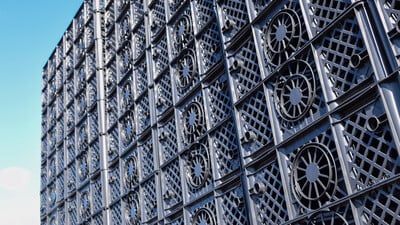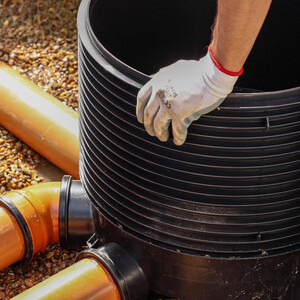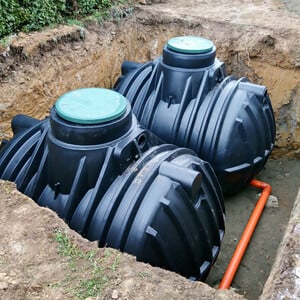
Soakaway Crates Explained
Soakaway crates (also known as storm crates, infiltration crates, anti-flooding blocks or attenuation crates) have an integral part to play in the prevention and reduction of surface water flooding in built up areas. Buried underground, they provide an effective infiltration system through their sturdy geocellular structure which allows rainwater to drain into them to be temporarily stored before being slowly released into the ground below or into a suitable body of water. The controlled release ensures that there is no damage to the ground under the crate. This process helps to even out the flow of rainwater, particularly from intense downpours, without over-loading the local sewer system.
Soakaway crates are most often used in towns and cities where much of the ground is covered by impermeable substances like concrete, paving blocks and tarmac. The installation of local rainwater infiltration systems is often a legal requirement on construction projects.
Soakaway Crates and Climate Change
Climate change is the most likely cause of increases in the overall volume and intensity of rainfall in the UK. As the overall average air temperature increases, so does the atmosphere’s ability to hold moisture; just think of what it’s like in a tropical rainforest! Greater volumes of water vapour in the air leads to more intense rainfall episodes which can result in increased water run-off, especially on hard surfaces. If not dealt with properly, localised flooding will occur.
Storm water crates are one element which can help provide resilience to climate change by protecting our towns and cities against flooding. Long-term, they can provide a very cost-effective solution to flood prevention and reduction, helping to protect the built environment.
At the March 2018 Flood and Coast Conference, the Environment Agency’s Chief Executive Sir James Bevan said: “every £1 invested in new flood schemes saves the economy £10 in damages avoided.”
Soakaway Crate Usage:
Soakaway crates can be used on virtually any site that would benefit from localised water infiltration such as under roads, car parks, pavements and in shopping centres or sports stadiums.
Installing Soakaway Crates
Soakaway crates are designed to be stacked together – up to 10 layers high – depending on how much run-off you calculate that they will need to deal with. They are capable of bearing loads of up to 60 tonnes from passing HGVS when used under roads (with a minimum earth covering of 500mm).
How Many Soakaway Crates Do I Need?
There are a number of factors which you need to consider when thinking about soakaway size, and you may need to seek specialist advice to accurately calculate how many crates are needed. Unfortunately calculating soakaway crates is not a one-size-fits-all. Soakaways are calculated by determining the permeability of the ground and working out the catchment area that the stormwater crates will need to serve. You will then need to consider the capacity of any existing drainage infrastructure. You will also need to determine the likely rainfall in the area based on historical data – it is advised that you use at least 5 years’ worth of data to account for less frequent but more intense rainfall events. All these factors need to be taken into account to calculate the volume of run-off that your storm water crates will need to deal with.
Do I Need To Use Geotextiles / Membrane with My Crates?
When used as an attenuation system, the soakaway crates need to be wrapped in 100g non-woven geotextile (also known as protection fleece) AND 300g impermeable membrane to create a temporary water storage facility. On very small systems, the membrane can be taped together. On large systems, joints will need to be welded together. The attached pipework feeds water in and takes water away in a controlled manner.
When used as a soakaway system, it is recommended that the stormwater crates are wrapped in 100g non-woven geotextile. This allows the water to pass into the crate without carrying soil particles with it and out of the crate slowly enough to avoid erosion of the soil below.
Free Take-Off Service
If you have a large site which requires a large number of soakaway crates, why not use our free take off service? Using your site drawings we can accurately plan the quantities of stock you will need. Just call us on 01730 77400 and ask to speak to a member of our technical team.
What is the Delivery Lead Time for Drainfast Soakaway Crates?
Drainfast carries plenty of stock of these items so you can look forward to speedy delivery. Many areas can enjoy next day delivery for items ordered by 5.00pm – see our delivery map for details.
Crate Credentials:
- Capacity: each crate can hold up to 300 litres of water
- Size: 1200mm (L) x 600mm (W) x 420mm (H)
- Weight: each crate weights around 18kg
- Maximum earth covering: 2 metres
- Max installation depth: 5 metres
- Material: crates are made from heavy duty polypropylene
Joining: crates can be quickly and easily clipped together just using your hand; each crate bought from Drainfast comes complete with 4 free clips. Crates can be joined with a minimum of 1 clip per contact face.



